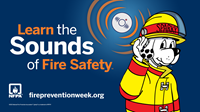Fire Prevention Week Oct. 3-9, 2021 Focuses on The Sounds of Fire Safety
10/4/2021 • 2 years ago
 The information on this page may be outdated as it was published 2 years ago.
The information on this page may be outdated as it was published 2 years ago.

Fire Prevention Week is October 3-9, 2021. The National Fire Protection Association® (NFPA), the official sponsor of Fire Prevention Week™ for 99 years, announced that “Learn the Sounds of Fire Safety™” is this year's theme. From beeps to chirps, this year’s campaign works to better educate the public about the sounds smoke alarms make, what those sounds mean, and how to respond to them.
According to the latest NFPA “Smoke Alarms in the U.S.” report, working smoke alarms in the home reduce the risk of dying in a reported fire by more than half (55 percent). However, almost three out of five home fire deaths occur in homes with no smoke alarms (41 percent) or smoke alarms that failed to operate (16 percent); missing or non-functional power sources, including missing or disconnected batteries, dead batteries, and disconnected hardwired alarms or other alternate current (AC) power issues, are the most common factors when smoke alarms fail to operate.
In a fire, mere seconds can mean the difference between a safe escape and a tragedy. Fire safety education isn’t just for school children. Teenagers, adults, and the elderly are also at risk in fires, making it important for every member of the community to take some time every October during Fire Prevention Week to make sure they understand how to stay safe in case of a fire.
Remember that carbon monoxide, a product of combustion, is a poisonous gas which is odorless, combustible, and invisible. Firefighters have air sampling meters which can determine the presence of gases (including carbon monoxide) in the atmosphere.
Always have an emergency exit plan, and an alternate plan. When you exit, shut the door behind you to slow down the spread of smoke into hallways and stairways. Call 911 from a safe area. Meet the firefighters when they arrive and give the them any additional information on the alarm or emergency. This week is a good time to review the emergency exit plan and outside meeting place with your family or housemate.
The following safety tips are recommended to help you Learn the Sounds of Fire Safety:
- A continuous set of three loud beeps—beep, beep, beep—means smoke or fire. Get out, call 9-1-1, and stay out.
- A carbon monoxide detector in alarm will send a series of four loud beeps – beep, beep, beep, beep.
- A single “Chirp” every 30 or 60 seconds means that the battery needs to be replaced.
- All smoke alarms must be replaced after 10 years.
- Chirping that continues after the battery has been replaced means the alarm is at the end of its life and the unit must be replaced.
- Make sure your smoke and CO alarms meet the needs of all your family members, including those with sensory or physical disabilities.
Link to Fire Prevention Week Tip Sheet
Family Action Plan (in English and Spanish)
Visit www.firepreventionweek.org for more safety information.